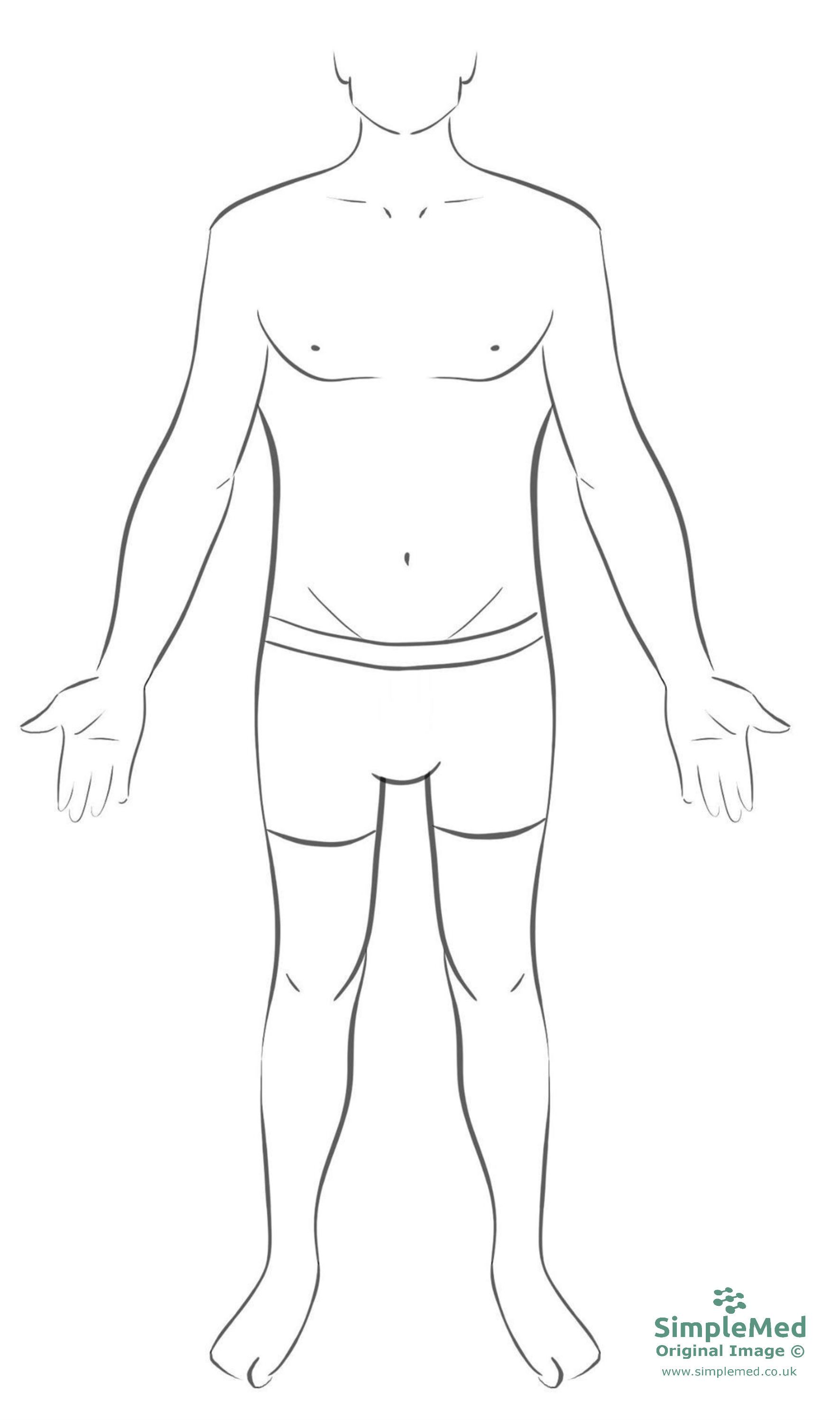Next Lesson - Structure of the Muscles
Abstract
- The anatomical position is the ‘normal’ position of the body and is used to describe movements of the body.
- There are a number of important anatomical terms used to describe the anatomical location or the movements of a body part. These terms are important to learn as it allows clear communication between medical professionals.
Core
The anatomical position is the position used to describe the ‘normal’ position of the body. It is a state of standing, with palms facing forward and feet pointing forward. In males, the anatomical assumes that the penis is erect (not shown below).

Image - The anatomical position
SimpleMed original by Bethany Turner
Left – the patient’s left, the observers right.
Right – the patient’s right, the observers left.
Superior – above, or towards the head, e.g. the knee is superior to the ankle.
Inferior – below, or towards the feet, e.g. the knee is inferior to the hip.
Anterior – towards the front of the body, in front of, e.g. the heart is anterior to the spine.
Posterior – towards the back of the body, behind, e.g. the spine is posterior to the heart.
Lateral – away from the midline of the body, e.g. the ears are lateral to the nose.
Medial – towards the midline of the body, e.g. the nose sits medial to the ears.
Proximal – closer to the trunk of the body, or to another specified thing, e.g. the shoulder is proximal to the wrist. This also applies to the GI tract, e.g. the oesophagus is proximal to the anus.
Distal – further away from the trunk of the body, or from another specified thing, e.g. the fingers are distal to the elbow. This also applies to the GI tract, e.g. the colon is distal to the stomach.
Superficial – closer to the surface of the body, e.g. the skin is superficial to the muscle.
Deep – far from the body surface, e.g. the muscle is deep to the skin.
Contralateral – on opposite sides, e.g. the left arm is contralateral to the right leg.
Ipsilateral – on the same side, e.g. the left arm is ipsilateral to the left leg.
Cranial – toward the head, same as superior. Used when describing embryos.
Caudal – literally toward the tail, same as inferior. Used when describing embryos.
Note that directional terms can be combined e.g. the right eye is superolateral to the tip of the nose.
Flexion – decreasing the angle of a joint, e.g. bending the elbow.
Extension – increasing the angle of a joint, e.g. straightening the elbow.
Dorsiflexion – decreasing the angle of the ankle joint, e.g. drawing the toes up so the angle of the ankle is around 90 degrees.
Plantarflexion – increasing the angle of the ankle joint, e.g. pointing the toes, so the angle of the ankle is around 180 degrees.
Elevation – moving a body part in a superior direction, e.g. shrugging the shoulders.
Depression – moving a body part in an inferior direction, e.g. slumping the shoulders.
Eversion – rotating the ankle joint so the sole of the foot is facing laterally.
Inversion – rotating the ankle joint so the sole of the foot is facing medially.
Abduction – moving something away from the midline, e.g. moving the arm from anatomical position to at a right angle to the body (directly out to the side.)
Adduction – moving something towards and/ or across the midline, e.g. moving the arm from directly out to the side back into anatomical position.
Lateral rotation – turning something away from the midline, e.g. rotating the leg so the foot is pointing out to the side.
Medial rotation – turning something towards the midline, e.g. rotating the leg so the foot is pointing inwards towards the other leg.
Pronation – rotating the flexed forearm from palm up to palm down.
Supination – rotating the flexed forearm from palm down to palm up.
Retraction – posterior movement of the shoulder joint, e.g. pushing the shoulders back and pushing out the chest.
Protraction – anterior movement of the shoulder joint, e.g. pushing the shoulders forwards to collapse the chest.
Radial deviation - sideways movement at the wrist joint that moves the thumb-side of the hand closer to the radius. It can also be known as radial flexion.
Ulnar deviation - sideways movement at the wrist joint that moves the little finger-side of the hand closer to the ulnar. It can also be known as ulnar flexion.
In addition to flexion and extension of the fingers.
Abduction of the fingers – splaying the fingers of one hand.
Adduction of the fingers – pushing the fingers of one hand toward each other.
Opposition – touching the thumb and little finger together.
Reposition – moving the thumb away from the little finger.
Abduction – moving the thumb away from the palm anteriorly.
Adduction – moving the thumb toward the palm posteriorly.
Flexion – moving the thumb toward the palm medially.
Extension - moving the thumb away from the palm laterally.
Prone – lying face down.
Supine – lying face up.
Lithotomy position – with patient lying supine and hip and knee held at right angles. Used with stirrups to facilitate childbirth.
Lateral – lying on the side.
Sitting – as in a chair.
Edited by: Dr. Thomas Burnell and Dr. Ben Appleby
- 11748

